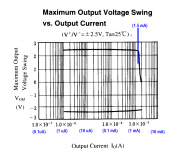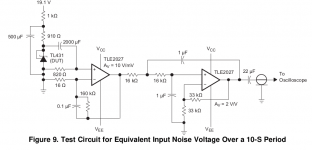I was doing some noise measurements with OPAmp available on a market, and discovered that NJM2122 beats up any other OPA that I tryed to evaluate.
I mostly interested in low frequency end, even in 0.1-10Hz for methrological purposes (oscilloscope pictures), but it doesn't make difference - spectrum is the same up to 20 kHz and above.
Have a look: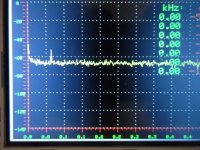
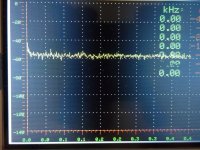
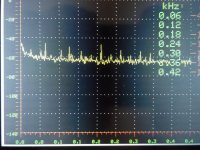
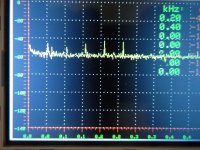
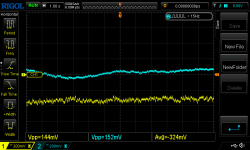
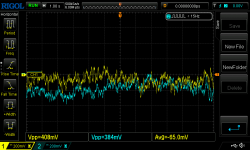
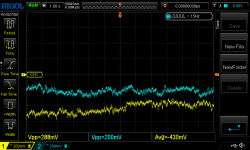
I mostly interested in low frequency end, even in 0.1-10Hz for methrological purposes (oscilloscope pictures), but it doesn't make difference - spectrum is the same up to 20 kHz and above.
Have a look:







Last edited:
Yeah, it is a low noise device, but that is it's only strong point...most of the remaining attributes are ordinary at best...I'm not interested, sorry.
Mike
Mike
seems only useful as a small signal amplifier (they suggest mic pre): https://www.nisshinbo-microdevices.co.jp/en/pdf/datasheet/NJM2122_E.pdf
Well, the DIP package can be used up to +/- 10 V, the SOP to +/- 7 V. It is stable only for a gain of at least 30 dB, and it is bipolar, so mic preamp only if talking about a dynamic microphone.
What does it means?The OPA1656 can still rest securely… 🙂
Output current, power voltages, stability is not the subject of this topic.
Some people very proud of capasitive multiplier, BJT + electrolytic cap. The Only invention in the electronics field they've done.
??? Not sure what you are talking about with cap Mx, electrolytic caps and BJTs?
I thought we are talking about superlative opamps for audio?
My opinion is that the OPA1656 is probably one of the finest opamps for audio. I have used hundreds of these and they do work very well and sound fantastic.
Low noise, low distortion, 100mA current output, +/-18v rails, and it sounds great!
Let me tell you it’s features (from data sheet)…
• Ultra-low noise:
– Voltage noise: 2.9 nV/√Hz at 10 kHz
– Current noise: 6 fA/√Hz at 1 kHz
• Low distortion:
– 0.000029% (–131 dB) at 1 kHz
– 0.000035% (–129 dB) at 20 kHz
• High open-loop gain: 150 dB
• High output current: 100 mA
• Low input bias current: 10 pA
• Slew rate: 24 V/μs
• Gain bandwidth product: 53 MHz
• Rail-to-rail output
• Wide supply range:
±2.25 V to ±18 V or 4.5 V to 36 V
• Quiescent current: 3.9 mA per channel
https://www.ti.com/lit/ds/symlink/opa1655.pdf?HQS=dis-mous-null-mousermode-dsf-pf-null-wwe&ts=1666989116374&ref_url=https%3A%2F%2Fwww.mouser.com%2F
I also like the OPA1642 and in many cases, the 1642 works just as well and technically slightly lower noise but not as high of output current.
I thought we are talking about superlative opamps for audio?
My opinion is that the OPA1656 is probably one of the finest opamps for audio. I have used hundreds of these and they do work very well and sound fantastic.
Low noise, low distortion, 100mA current output, +/-18v rails, and it sounds great!
Let me tell you it’s features (from data sheet)…
• Ultra-low noise:
– Voltage noise: 2.9 nV/√Hz at 10 kHz
– Current noise: 6 fA/√Hz at 1 kHz
• Low distortion:
– 0.000029% (–131 dB) at 1 kHz
– 0.000035% (–129 dB) at 20 kHz
• High open-loop gain: 150 dB
• High output current: 100 mA
• Low input bias current: 10 pA
• Slew rate: 24 V/μs
• Gain bandwidth product: 53 MHz
• Rail-to-rail output
• Wide supply range:
±2.25 V to ±18 V or 4.5 V to 36 V
• Quiescent current: 3.9 mA per channel
https://www.ti.com/lit/ds/symlink/opa1655.pdf?HQS=dis-mous-null-mousermode-dsf-pf-null-wwe&ts=1666989116374&ref_url=https%3A%2F%2Fwww.mouser.com%2F
I also like the OPA1642 and in many cases, the 1642 works just as well and technically slightly lower noise but not as high of output current.
Last edited:
I'm not critical of your results or it's noise performance I'm just pointing out it's a very specialist part with limited application to audio.What does it means?
Output current, power voltages, stability is not the subject of this topic.
I see. My argument is that many applications in the audio domain not necessaraly in the signal 20-20k path. Low noise power suppllies, for example. Or buffering amplification and measurements with circuits that in the signal chain. ADC buffers.I'm not critical of your results or it's noise performance I'm just pointing out it's a very specialist part with limited application to audio.
So far I can't get stable noise data with any TI IC. Tryed opa1611 opa1602 - both very sensitive to RF enviroment. LM4562, opa1656, opa1641, opa145 all same problem. Don't llike an idea to design triple shielding box for any simple project I may come up with. NJM is very good in this aspect, perfectly works even on a breadboards.
Those TI opamps are all well known, tried and true. We are not doing anything special with shielding. In fact, I often run PCBs without any case or chassis. Are you using bypass 100nF X7R caps right next to the power supply rail pins (literally no more than 2 to 3mm away)?
I have my bypass caps placed on the bottom side directly next to the pad.
Here is a buffer board with two OPA1656 or 1642’s used in open air. Extremely noise free.

Here is measured FFT showing noise floor. The 60Hz bump is pickup through the air and is there even when opamp is turned off.

I have my bypass caps placed on the bottom side directly next to the pad.
Here is a buffer board with two OPA1656 or 1642’s used in open air. Extremely noise free.
Here is measured FFT showing noise floor. The 60Hz bump is pickup through the air and is there even when opamp is turned off.
Glad for you. There is another thread devoted to opa1656 on this forum.
Come back if have something to say about NJM2122
Come back if have something to say about NJM2122
"new shining star" - no way, it's only advantage is low noise for the money, otherwise it seems pretty uninteresting....
I'll also take an opa1656, opa1642, or an opa1612 for lowest noise.....
I'll also take an opa1656, opa1642, or an opa1612 for lowest noise.....
Glad for you. There is another thread devoted to opa1656 on this forum.
Come back if have something to say about NJM2122
I suppose if you help us identify the specific area of interest for your NJM2122, people will be less judgmental; you have posted in the Amplifiers section - hence what immediately comes to mind is comparing that NJM2122 you mentioned to something meaningful that can work in typical audio pre-amp applications.
What exactly is "methrological purposes"?
Here is the circuits.
I'm not satisfied with TLE2027. Measurements I've done so far, shows that TL431 is not the same if it made by TI, ST or OnSemi. Difference could reach x5 times. Also I was evaluating LDO, most of them quite noisy, level is not acceptable for high gain pre-amp, where PSRR getting limited by AOL
I'm not satisfied with TLE2027. Measurements I've done so far, shows that TL431 is not the same if it made by TI, ST or OnSemi. Difference could reach x5 times. Also I was evaluating LDO, most of them quite noisy, level is not acceptable for high gain pre-amp, where PSRR getting limited by AOL
Attachments
Well, yes.... in that circuit where there's almost no output current sourced/sank, the NJM2122 will do well due to its very low noise performance.
It is a very specific implementation, though... Have you considered lowering the values of those resistors used in the circuit? Would that help..? I think it would.
You see, you should've mentioned the actual circuit straight away, so that people know what's going on, i.e. this is not an audio signal pre-amp application.
The results of these measurements could have been helpful to me personally... because a long time ago I used TL431 in a DAC application 🙂
It is a very specific implementation, though... Have you considered lowering the values of those resistors used in the circuit? Would that help..? I think it would.
You see, you should've mentioned the actual circuit straight away, so that people know what's going on, i.e. this is not an audio signal pre-amp application.
The results of these measurements could have been helpful to me personally... because a long time ago I used TL431 in a DAC application 🙂
Last edited:
Yeah, a 431 is noisy, I use them a lot, they're flexible, precise and cheap, but always with a low pass filter....
But you should worry more about offset voltage with a gain of 10000, the noise of the first buffer amp don't really matter that much.... The njm2122 with a offset of max 6 mV is actually useless in the shown schematic, the 100 uV tle2027 is better there.
You would also need to adjust resistor values, a bipolar amp need to see same resistance on both inputs.
But if the goal is to measure low frequency noise, you need to find a low offset, low noise part, there are better out there.... Both Analog Devices and TI have good selection tools.
But you should worry more about offset voltage with a gain of 10000, the noise of the first buffer amp don't really matter that much.... The njm2122 with a offset of max 6 mV is actually useless in the shown schematic, the 100 uV tle2027 is better there.
You would also need to adjust resistor values, a bipolar amp need to see same resistance on both inputs.
But if the goal is to measure low frequency noise, you need to find a low offset, low noise part, there are better out there.... Both Analog Devices and TI have good selection tools.
I don't think lowering R is make sense, since most amplification done by first stage. Anyway, it's a trade C size vs R in LPF.Well, yes.... in that circuit where there's almost no output current sourced/sank, the NJM2122 will do well due to its very low noise performance.
It is a very specific implementation, though... Have you considered lowering the values of those resistors used in the circuit? Would that help..? I think it would.
You see, you should've mentioned the actual circuit straight away, so that people know what's going on, i.e. this is not an audio signal pre-amp application.
The results of these measurements could have been helpful to me personally... because a long time ago I used TL431 in a DAC application 🙂
And it's to me to decide what to mention in the initial message. Don't like - don't eat.
Agree on offset, pretty high. I've done tests up to 80 dB - get 2-3 V at the outputs, have to adjust injecting bias current to input. Nothing fancy, pot to +- and wiper via 10k to one of the input. Same offset issue apply to any LM833, NE5532, NE5534, NJM4580/2068 etc.Yeah, a 431 is noisy, I use them a lot, they're flexible, precise and cheap, but always with a low pass filter....
But you should worry more about offset voltage with a gain of 10000, the noise of the first buffer amp don't really matter that much.... The njm2122 with a offset of max 6 mV is actually useless in the shown schematic, the 100 uV tle2027 is better there.
You would also need to adjust resistor values, a bipolar amp need to see same resistance on both inputs.
But if the goal is to measure low frequency noise, you need to find a low offset, low noise part, there are better out there.... Both Analog Devices and TI have good selection tools.
Seems nobody here me. I've tryed many IC from AD and TI. None of them even close competitor to NJM. See oscilloscope images and Spectrum Charts (done with MCP3561). AD and TI costs x10 times higher, performs x3 times worse. Not stable. There is a chance, certanly, that IC I bought from arrow & mouser could be counterfait via "akamai technologies" mafia ring.
Subject of this thread is not about sales, market or selection.
Who alredy knows ultra low noise area and application, have measured NJM2122 and want to share results - welcome.
- Home
- Amplifiers
- Solid State
- Low Noise OPAMP NJM2122 is a new shining star
